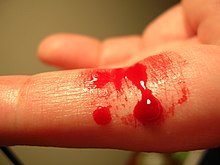Color

The coloring matter of blood (hemochrome) is largely due to the protein in the blood responsible for oxygen transport. Different groups of organisms use different proteins.
Hemoglobin
Hemoglobin is the principal determinant of the color of blood in vertebrates. Each molecule has four heme groups, and their interaction with various molecules alters the exact color. In vertebrates and other hemoglobin-using creatures, arterial blood and capillary blood are bright red, as oxygen imparts a strong red color to the heme group. Deoxygenated blood is a darker shade of red; this is present in veins, and can be seen during blood donation and when venous blood samples are taken. This is because the spectrum of light absorbed by hemoglobin differs between the oxygenated and deoxygenated states.
Blood in carbon monoxide poisoning is bright red, because carbon monoxide causes the formation of carboxyhemoglobin. In cyanide poisoning, the body cannot utilize oxygen, so the venous blood remains oxygenated, increasing the redness. There are some conditions affecting the heme groups present in hemoglobin that can make the skin appear blue – a symptom called cyanosis. If the heme is oxidized, methemoglobin, which is more brownish and cannot transport oxygen, is formed. In the rare condition sulfhemoglobinemia, arterial hemoglobin is partially oxygenated, and appears dark red with a bluish hue.
Veins close to the surface of the skin appear blue for a variety of reasons. However, the factors that contribute to this alteration of color perception are related to the light-scattering properties of the skin and the processing of visual input by the visual cortex, rather than the actual color of the venous blood.
Skinks in the genus Prasinohaema have green blood due to a buildup of the waste product biliverdin.
Hemocyanin
The blood of most mollusks – including cephalopods and gastropods – as well as some arthropods, such as horseshoe crabs, is blue, as it contains the copper-containing protein hemocyanin at concentrations of about 50 grams per liter. Hemocyanin is colorless when deoxygenated and dark blue when oxygenated. The blood in the circulation of these creatures, which generally live in cold environments with low oxygen tensions, is grey-white to pale yellow, and it turns dark blue when exposed to the oxygen in the air, as seen when they bleed. This is due to change in color of hemocyanin when it is oxidized. Hemocyanin carries oxygen in extracellular fluid, which is in contrast to the intracellular oxygen transport in mammals by hemoglobin in RBCs.
Chlorocruorin
The blood of most annelid worms and some marine polychaetes use chlorocruorin to transport oxygen. It is green in color in dilute solutions.
Hemerythrin
Hemerythrin is used for oxygen transport in the marine invertebrates sipunculids, priapulids, brachiopods, and the annelid worm, magelona. Hemerythrin is violet-pink when oxygenated.
Hemovanadin
The blood of some species of ascidians and tunicates, also known as sea squirts, contains proteins called vanadins. These proteins are based on vanadium, and give the creatures a concentration of vanadium in their bodies 100 times higher than the surrounding seawater. Unlike hemocyanin and hemoglobin, hemovanadin is not an oxygen carrier. When exposed to oxygen, however, vanadins turn a mustard yellow.
Comments
Post a Comment